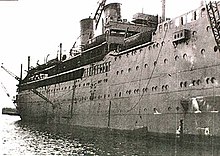Sinking the Arandora Star

The sinking of the Arandora Star in the Atlantic on July 2, 1940 by the German submarine U 47 was a shipping disaster in World War II , in which more than 800 people were killed.
prehistory
When the Second World War broke out, around 75,000 refugees from Nazi Germany were living in Great Britain, most of them Jews , representatives of the banned parties and opponents of the regime. But German National Socialists also lived and worked in the country. The German attack on the Netherlands, Belgium and Luxembourg , in which, according to rumors, Germans living there helped the invading forces, sparked great fears in Great Britain. Winston Churchill ordered all Germans and Austrians living in the possible invasion zones of Great Britain to be interned as enemy aliens without distinction . After Italy entered the war in June, the measure was extended to Italians. Most of them met people who had been persecuted and imprisoned in their home countries.
In order to relieve the rapidly overcrowded camps , the British government asked Canada and Australia to take in internees and began organizing ship transports there.
catastrophe
The former ocean liner Arandora Star (built in 1927) started on July 1, 1940 without a convoy from Liverpool with around 1,200 people on board. Most of the internees were Italians, and to a lesser extent Germans and Austrians. The port of destination was St. John's (Newfoundland) . A few hundred nautical miles northwest of the Outer Hebrides it crossed the course of the German submarine U 47 , commanded by Günther Prien , which was on its way back from a four-week attack voyage. Prien fired the last torpedo at the Arandora Star .
The explosion caused panic on the ship. Internees and crew tried to get hold of life jackets and lifeboats. Many jumped desperately overboard, often from great heights. Around 700 internees and 100 men of the occupation died. The rest of them were taken on board by ships hurrying up, sometimes after hours.
The event sparked a heated debate among the British public about how to deal with the refugees and caused a shift in public opinion.
Commemoration
Over the decades, memorials have been created in various churches and cemeteries, including on coastal strips where corpses of the drowned people had washed up, the most important at St Andrew's Cathedral in Glasgow , which opened on the 70th anniversary of the disaster, July 2, 2010.
Web links
- Lars-Broder Keil : Germans against Germans . Die Welt, August 2, 2010
- Peter Gillman, Leni Gillman: "Collar the Lot". How Britain interned and expelled is wartime refugees. Quartet, London 1980
Coordinates: 55 ° 20 ′ 0 ″ N , 10 ° 33 ′ 0 ″ W.

